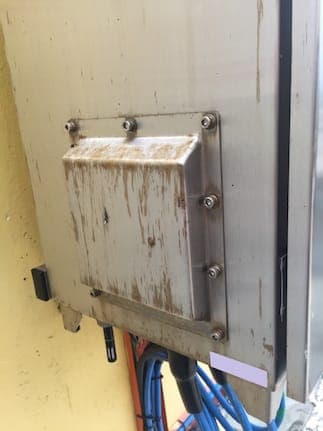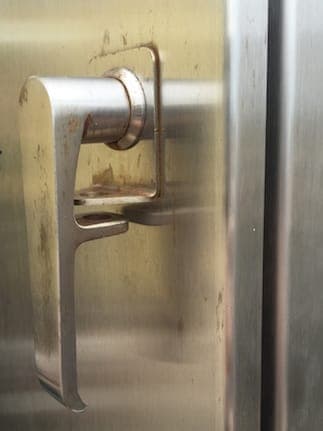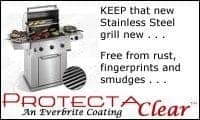
Curated with aloha by
Ted Mooney, P.E. RET

The authoritative public forum
for Metal Finishing 1989-2025

-----
Will stainless steel 304 rust?
Q. We purchased door pull handles from Canada. They were made from stainless steel 304 hair line finish and in polished finish. After installation on external doors, the hairline finish (US32D) showed rust marks. We tried cleaning but they always come back.
Is this normal for SST 304 US32D in high humid and hot areas?
Is there a permanent solution or we have to keep cleaning them. Are there any technical publication they states that this is normal for stainless steel 304.

doors and hardware - Dubai, United Arab Emirates
2003
A. 304 WILL rust. 304 will rust faster in hot humid climates. 304 will rust very fast in hot humid climates as door handles frequently grasped with acid sweaty perspiration.
Clean the door handles frequently with rubber rubber gloves ⇦ this on eBay or Amazon [affil links] and a rag dipped in 30% Nitric Acid.
Clean the door handles less frequently if you take them off the doors and Passivate in 50% Nitric Acid. The Nitric Acid oxidizes the exposed nickel into a controlled oxide and at the same time it removes the iron from the surface.

Robert H Probert
Robert H Probert Technical Services
Garner, North Carolina

2003
A. By looking at the picture it is obvious that you have some pit corrosion on the surface. This is very difficult to remove! The nitric acid will not normally remove it. Some of the 304 stainless steel on the market today is not very good, but all 304SS is subject to corrosion in chloride atmospheres. Good lots of 304 should withstand the conditions you mention.
There are other formulations on the market that can help, but we have seen many situations like this recently that are constant maintenance headaches.

Lee Kremer
Stellar Solutions, Inc.
McHenry, Illinois

2003
A. For true corrosion resistance in humid, saline areas like UAE, I believe you should COAT stainless steel with a clear thermoplastic - this retains the appearance of the finish and some manufacturers boast a 25 year warranty. Some sintercoat LLDPE thermoplastics have been in use for 21 years now, and have been very successful in South Asia, which has similar high UV, humid and saline conditions.
[LLDPE based polymers have greater adhesion to the substrate
- the bond is chemical. Also, some LLDPE Sintercoat coatings are acid resistant, non-toxic, food & water contact safe and fire rated in a similar manner to pipe insulation- much safer in the event of a fire, where most of the damage is caused by smoke and fumes.
I was employed by a construction company, and I have witnessed doors constructed from SS316 corrode so badly over a seven year period they had to be replaced! [adjacent Victoria Harbour, HK]. At that time, we selected a plastic coating solution and our client was very happy with the result [so far!]
I believe the HK company with this coating recently re-opened offices in Kuwait for the application of this coating and may be able to help [I found them originally through the internet, they previously coated pipes, fences, steelwork etc etc in the Middle East [Kuwait; Dubai] many years ago -the applicator is based in Dubai also.
I wish you best of luck solving your problem.
- Hong Kong
2005
A. Hi....
It is a clear sign of Pitting corrosion. In a place like UAE, it is very common due to the saline air conditions.
It would have been better, had you specified the handles made of AISI 316L which could have given you much more longer life.The simple solution would be, take a 80 Grit Emery Strip & polish it with hand which will remove the Pits immediately. This can be done whenever you find the pitting.
- Nairobi, Kenya
2006
A. We deal with this problem all the time. We are a global company who specialize in the correction and protection of stainless steel in harsh environment's, the worst being indoor pools. We find that regardless of grade (304/316) the tea staining or pitting will occur. This is mostly due to the brushed finish. Rolled or mirror finishes do not suffer from this.
Tony Semple- London United Kingdom
June 6, 2013
Tarnishing of Stainless Enclosures
October 20, 2016Q.
We use 304 stainless enclosure on a number of our products, which are installed outdoors.
On some of those, we find the enclosures to show tarnishing/corrosion at most surfaces.
This is more evident on units installed in aggressive environments (coastal sites in high humidity, high temperature climates).
We often clean this, but it takes a few months and appears again.
Recently, a customer insisted that other products with 304 enclosure, on the same site with our products, show no tarnishing at all, even after 10 years!
We don't know if we believe this, although a photo was provided.
Our supplier is adamant that all stainless enclosures will tarnish, especially in coastal areas.
They advised that 316 might fare better, but eventually will exhibit same effect.
I'd like to hear your views and inputs on this.
- Is there a real advantage in using 316 enclosures in general and in coastal areas in particular?
- Is there a coating or post treatment that we can apply to 304 or 316 to prevent this tarnishing?
Project Manager - N. Ireland



P.S.: The handle is actually 316.
A. Either passivation or electropolishing of the stainless steel will enhance the corrosion resistance of your enclosures.
Lyle Kirmanconsultant - Cleveland Heights, Ohio
October 21, 2016
A. Re: the rusting of a stainless steel cabinet --
Some years ago I worked for a company producing food-handling equipment. A customer complained some units were rusting. On investigation we discovered that the contractor who grit-blasted our unfinished products had used grit previously used for treating ordinary mild steel items. This resulted in ferrous particles being forced into the surface of stainless items.
Re-blasting with clean grit solved the problem.
Engineer - Welshpool, Mid-Wales, UK
October 24, 2016
A. Salman,
The biggest factors of influence here are:
*What grade of stainless, and where did it come from. 316 is more corrosion resistant than 304, but also costs more. Stainless made in certain countries are of lower quality than that made in other countries, and all of it is of lower quality than it was a few decades ago.
*Environment. You know this one already. Marine/coastal environments are bad because of the ocean salt. Swimming pools also have the high chloride problem, as does manufacturing equipment that is frequently cleaned with bleach or chloride based cleaners.
*Surface finish. Smoother is more corrosion resistant, whether by electropolishing or mechanical polishing. Grained finishes are especially hit hard near the ocean.
*Passivation treatment. In a coastal, etc., environment, even the best passivation on good 316 will not be protection forever, but it will hold up for longer initially. Periodic passivation treatments help keep things looking nice whether 316 or 304. Welds and iron-contaminated areas must be passivated or they will rust very quickly.

Ray Kremer
Stellar Solutions, Inc.
McHenry, Illinois

October 25, 2016
November 2, 2016
![]() Thank you all for your responses.
Thank you all for your responses.
Our supplier does passivate the enclosures, and they have separate facilities for mild steel and stainless. They seem very aware of the risks or consequences of a cross contamination.
We've asked our supplier to carry out salt spray testing on 304 and 316 parts, in brushed, mirror and rolled finish. Hopefully this will give us an idea if a different finish will provide better protection, and give an indication how better the 316 will perform compared to 304.
- N. Ireland
finishing.com is made possible by ...
Protect stainless steel grills & outdoor kitchens with Everbrite

Q, A, or Comment on THIS thread -or- Start a NEW Thread